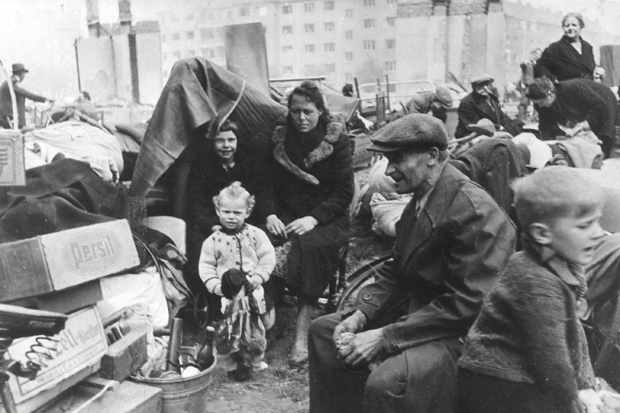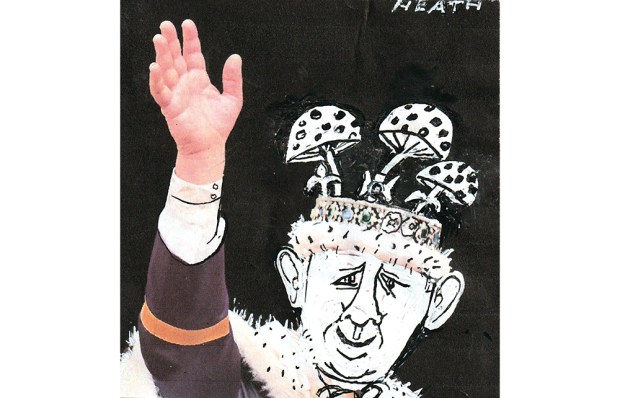In the early hours of 25 July 1943, nearly 800 RAF Halifaxes and Lancasters launched a 50-minute bombing raid on the Third Reich’s second largest city, Hamburg. The pilots used the neo-Gothic spire of St Nikolai’s church in the city’s historic heart as a landmark and killed 1,500 people.
Three nights later, just after midnight, the bombers returned. What was to follow was immeasurably worse. The RAF’s target was the city’s overcrowded working-class districts, Hammerbrook, Hamm and Borgfelde, to which many of those who had lost their homes in the previous bombardment had fled. Unusually warm weather and heavy loads of incendiaries combined to create a hurricane-like firestorm. In the face of temperatures of 800˚C, ‘every human resistance was quite useless,’ Hamburg’s chief of police later wrote. People jumped into canals and waterways, swimming or standing for hours; many were asphyxiated in bomb shelters as the fires raging in the streets devoured every trace of oxygen.
Two more overnight raids would follow, complemented by heavy American daytime bombing of Hamburg’s ports, but it was on the night of 27 July that most of Operation Gomorrah’s 40,000 victims would die. The ten-day pounding of Hamburg was, Air Chief Marshal Arthur ‘Bomber’ Harris conceded, ‘incomparably more terrible’ than anything thus far visited upon Germany. Ten square miles of the city were obliterated, forcing 900,000 of its inhabitants to flee. In the aftermath, suggested a contemporary account, ‘Rats and flies were the lords of the city.’
There will be little mention of the firestorm which consumed Hamburg as Britain marks the 70th anniversary of the end of the war this week. While Operation Gomorrah was more devastating — and claimed a greater death-toll — it is the destruction of Dresden which has become, in the words of the historian Ian Kershaw, ‘the symbol of the bombing war’. In part this reflects the fact that with its ports, armament factories and shipbuilding facilities, Hamburg could easily be presented as a military target — though it was the morale of the civilian population, particularly industrial workers, that the bombing sought to sap.
Britain, as victor, claims the right to look away from the more uncomfortable aspects of some of its actions. Germans are confronted with a more acute dilemma: how, as the losers and as those responsible for so many atrocities, do they mark the terrible losses endured by their own civilian population during the war?
Those complexities are laid bare at St Nikolai’s church. The spire still soars above it, but the walls are all that remain of the magnificent nave. Beneath them, the crypt is home to the city’s museum which charts those ten fateful days. It recounts not simply the suffering of its inhabitants and what the Allies hoped to achieve, but also the stories of the RAF pilots who carried out the bombings and the lasting psychological damage some of them later endured. It also details the ‘double misery’ of the foreign forced labourers and concentration camp prisoners from nearby Neuengamme who were dragooned into recovering and burying the dead and the ‘suicide squads’ detailed to defuse unexploded devices.
But the museum also charts the rather more fraught debate about where the responsibility for the bombing should lie. Remembering the victims of Hamburg is complicated by the fact that the first commemoration of the bombing took place barely three months after it occurred. Already, the Nazi propaganda machine had attempted to turn disaster into triumph by evoking the spirit of unity and comradeship which had been forged by Hamburg’s citizens amid the ruins. Nothing symbolises that better than the cemetery in Ohlsdorf where, atop a mass grave, monumental oak panels were constructed listing the districts destroyed in the raids. No individuals are named, testament to the Nazis’ determination not to mark the victims of ‘enemy terror’ but to celebrate the ‘common destiny’ of Hamburg’s inhabitants.
The first postwar remembrance saw the city’s mayor, Max Brauer, recall the ‘death of the peaceable citizens of Guernica, Rotterdam and Coventry’ but sidestep the question of guilt and absolve the German people of blame. They, he suggested, were the first victims to be led to ‘the slaughter by an inhuman dictatorship’. Beyond that, responsibility was laid at the door of somewhat amorphous ‘demons’ and ‘violent criminals’. Forty years later, the tone of remembrance was altogether different, as one of Brauer’s successors, Henning Voscherau, publicly asked: ‘If the Allies had not had the courage and determination to answer Nazi violence with violence in order to stop the Germans running amok, would liberation, renewal, a democratic future have been possible?’ Members of one anti-fascist group went further, disrupting a commemorative service to unfurl a banner reading ‘Operation Gomorrah: there is nothing to mourn’.
With its stark images of the Nazis’ annihilation of Warsaw and its recollection of the Blitz and bombing of Coventry and Rotterdam, the city’s museum acknowledges that the ‘fuse for the firestorm was lit in Germany’. Moreover, as a plaque at the top of St Nikolai’s spire attests, while the carpet-bombing of cities during the war breached international law, the roots of the catastrophe which befell Hamburg lay in January 1933, ‘when the National Socialists with the support of large parts of the elite and the population abolished democracy’.
But some prefer a less nuanced approach. In 2003, Ole von Beust became the first mayor of the city to charge that Operation Gomorrah was ‘a breach of civilisation’ and, in an address at St Nikolai, he chose to make no mention of the historical context, nor of the Nazis’ victims both elsewhere in Europe and in Germany itself. In the same spirit, the city’s exhibition that year controversially focused solely on those who died in Operation Gomorrah.
Von Beust’s remarks reflected a wider shift at the time toward an emphasis on Germans as victims, and not simply perpetrators, of the crimes of the second world war. As graphically illustrated by Jörg Friedrich’s 2002 book Der Brand, the destruction of Germany’s cities during the war was central to this new narrative.
From this perspective, it is possible to shift seamlessly from portraying the bombing of Hamburg as not simply wicked but futile. That, I think, would be a mistake. It’s true that the bombing didn’t have the hoped-for impact on the city’s contribution to the Nazi war effort: much of its port and industrial areas were up and running again by the autumn. Nor did it, as Harris hoped, provoke the populace into a revolt that brought the war to an early conclusion. But however terrible Operation Gomorrah was, it did serve a purpose in the end. It changed the attitude of many Germans, who may hitherto have been unaffected by the war, discrediting a leadership which was unable to ‘protect’ the population. As tales of the bombing spread throughout Germany, it provoked something called the ‘November mood’ of growing antipathy to the regime. Operation Gomorrah and the devastation of German cities meant that there could be no ‘stab in the back’ myth, as there was after 1918 when it suited people to believe that Germany had not lost the war fairly, but had been betrayed by their own home front. In this sense, Germany’s modern democracy was built on the rubble of its cities.
Got something to add? Join the discussion and comment below.
Get 10 issues for just $10
Subscribe to The Spectator Australia today for the next 10 magazine issues, plus full online access, for just $10.
You might disagree with half of it, but you’ll enjoy reading all of it. Try your first month for free, then just $2 a week for the remainder of your first year.














Comments
Don't miss out
Join the conversation with other Spectator Australia readers. Subscribe to leave a comment.
SUBSCRIBEAlready a subscriber? Log in